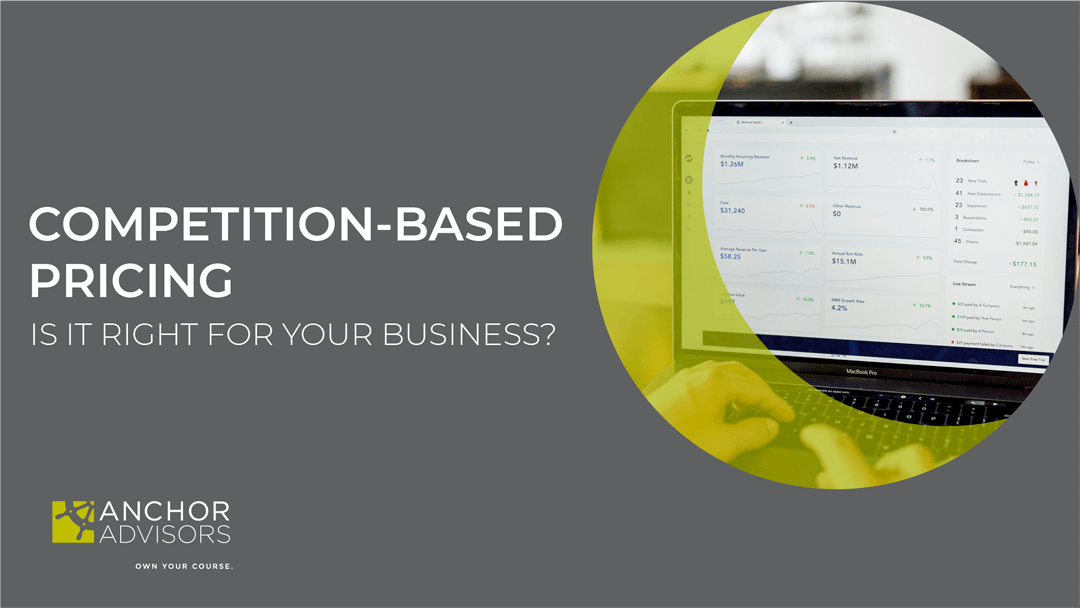Competition-Based Pricing – Is It Right for Your Business?
The Pros and Cons of Implementing a Competition-Based Pricing Strategy
One of the easiest forms of pricing is competitive-based pricing. Using this pricing strategy should ensure that you price in the ballpark of the price for similar services. If you do it well, a competition-based pricing strategy can help you raise prices without losing customers. But this doesn’t necessarily mean that it is the best strategy for you.
In this article, I explain the pros and cons of competition-based pricing. I share a few examples, discuss how to implement a competition-based pricing strategy, and you learn how to decide whether it is the right pricing model for your business.
Let’s get started with a competition-based pricing definition.
What is competition-based pricing?
A common way of [pricing is to measure your cost and then add on your desired profit. This cost-plus pricing tactic should ensure that you make the profit you want, but:
-
If you price too low, you may become swamped and unable to fulfill customer orders. That’s going to damage your reputation, lose customers, and could result in low (or no) profits.
-
If you price too high, you won’t sell the volume you expect or need, and you won’t make the money you expect
Competition-based pricing helps to eliminate these uncertainties by setting your price relative to that of which your competitors are charging. Plus, you don’t have to ‘guess’ on a price that customers will pay.
When you do your competitor analysis, you’ll discover a range of prices for the same or similar services to those that you offer. The piece of the puzzle that you must decide is where you want to be within that range.
Competition-based pricing is most effective when selling a relatively standard or undifferentiated service from your competitors. The more different you are in features or customer-centered service, the more you can earn a premium over the competition.
Having said this, it pays to understand competition-based pricing so you know why it isn’t for you, and the trap you should avoid.
Implementing a competition-based pricing strategy
This pricing strategy does pretty much what it says on the can. Your success in using it depends upon:
-
Knowing your market and who your competitors are
-
Discovering the prices that they are charging
-
Understanding how to price your service now that you have this knowledge
So, let’s get started.
1. Know your market and your competitors
Step number one is to know your competitors. This is a reasonably straightforward process.
I’m assuming that you have a thorough understanding of your service’s value to your potential customers.
Find out who is selling the same or similar services as you – either directly or indirectly:
-
Direct competitors are those offering the same or similar value proposition to your customers. There might be several design agencies nearby who all offer similar services (branding, messaging, design, digital marketing, etc.)
-
Indirect competitors are offering a substantially different product or service but that meets the same needs that your client has. In our example above, customers might be considering a Virtual Assistant, or an all you can eat design service, or a design marketplace. None of these offer “the same service”, but each might solve the client’s problem in a different way.
To learn about your competitors:
-
Ask your customers about the problem that they were having when they chose to buy your product and what other services they considered before choosing yours
-
Ask your salespeople which other companies are prospecting the same leads. Who do they see themselves competing against?
-
Search online for discussions in forums, on social media, for others experiencing those same problems. What solutions are being recommended to them?
2. Price discovery
Now that you know your competitors, it’s time to dig into their pricing. This step isn’t only about price. It’s also about ‘packaging’. What do I mean by this? Consider the following:
-
Company A and company B both sell Logo Design. They provide the same content, but company A provides you with 5 options and 3 rounds of revisions while company B only provides one option.
-
Packaging also extends to location. One firm might have US-based designers who are on your time zone, another may have international designers who work while you are asleep!
-
Packaging also includes differentiators. For example, let’s stick to the logo design. Both get you a logo but one might provide the design files so you can make changes later, while the other provides only the flat image files.
This in-depth pricing analysis will help you to separate competitors according to factors you have decided to include in your analysis. You can then select those competitors whose services most closely match those you are selling. This allows you to compare pricing more accurately.
3. Understanding how to price your service
Now you can map out your competitors, with a greater understanding of how they differentiate their services.
You can calculate an average price, and create a ladder of pricing – from the cheapest at the bottom to the most expensive at the top. This is your benchmark for pricing your service. The price you select depends upon your determination of value and selling strategy:
-
You might set a lower-than-average price if you want to sell quickly, or if you are seeking to acquire customers rapidly
-
By setting your price in line with the average price, you are, effectively, saying that your service matches the average
-
By pricing higher than average, you are aiming for higher-end customers who are prepared to pay premium prices for premium services
Remember, the price you put on your service affects the perception of the quality you provide. Psychologically, the higher your price the higher the perception of your brand. However, you must live up to that perception to build loyalty and brand recognition.
The pros and cons of competition-based pricing
Competition-based pricing strategies take advantage of how customers think, and they should also ensure that you position yourself correctly against your competition.
Let’s examine the main advantages and disadvantages of competition-based pricing.
The pros
-
Simplicity
Pricing against your competitors is reasonably easy to do. There is only a limited amount of research needed, and you can adjust prices easily should your competitors move their prices.
-
Accuracy
If you gather enough research and price data, your pricing should be accurate. This should mean that you attract the customers you expect to attract.
-
Targeting
If you still aren’t attracting the customers you expect, you know it is not pricing that is the issue. You can therefore investigate other factors – such as marketing, communication channels, and service quality – and determine what tweaks you must make to reach your target sales.
-
Low risk
When your price is based upon the same or similar services, it is hard to misprice. You should be able to win your fair share of the market, increasing your profits.
The cons
-
Mispricing
It is essential that you price your services accurately. If you make mistakes in your research, then you may misprice. You could miss sales opportunities, or sell at prices that don’t maximize your profit. Your perception of success may be flawed – you could be working harder and making less profit.
-
No acknowledgment of costs
By pricing compared to your competition, you may not build enough margin to adequately cover your costs and make a decent profit.
To avoid this, you should ensure that your service’s benefits from differentiators that make it unique with added value.
-
You become led by your competitors
Pricing to the market means that you are letting your competitors set your price. If your competitors don’t understand their costs, or the value that they are creating, they may set a “market price” that’s way too low. .
This can get even worse if your competitors decide to use low prices to gain market share or “buy growth”. Instead of chasing your competitor’s pricing you may be better off improving your service, increasing prices, and building a loyal customer base that will appreciate a more premium price point.
If you follow competitor prices, you could find it difficult to raise prices – one of the five keys to growing beyond $1M in sales.
-
The psychology of doubt
Lowering the price of your service may cause customers to doubt quality. The result could be lower sales and falling revenues on top of lower profit margins.
In every market, there’s room for a premium-priced competitor. Someone who goes over the top to please clients! In fact, I’ve written about how that could work here.
(Hey, you might enjoy my article ‘Are you offering flavorful French cuisine or serving a boring McBurger?’)
-
Continuous price maintenance
If you rely on competitor-based pricing strategies, you must be constantly aware of competitors’ prices. You’ll need to ensure that you have processes in place to maintain a watch on prices across your competitors. More hard work for potentially smaller profits.
So, should you employ competition-based pricing?
Competition-based pricing certainly has its merits. It is easy to use, provides accurate pricing, and allows you to pitch your service at prices that should be attractive to customers. But for who?
It’s a great pricing formula if you are selling products that are like those that your competitors sell. It’s not often used to sell services, and especially those where you add real value – which you do.
So, here’s the real problem with competition-based pricing. It’s never going to make you wealthy, because it is never going to let you sell at premium prices and set your own margins.
Worse, if you follow prices of competitors who have little or no clue about their costs, then you will be mispricing. You’ll miss opportunities, and suffer lower revenues and sales. Bang goes your profit, and your growth curve will slide downhill as you find yourself doing more.
So, why have I written this article? Because I really want you to avoid falling into the trap of focusing on your competitors when all that energy should be directed at differentiating yourself and creating a service that will earn you way more.
What pricing strategies should you be using? Tiered pricing could be good for you if you sell largely the same service over and over, but the absolute winner for customized services is value-based pricing.
You want to know more about pricing? Download my eBook ‘How to Raise Your Prices without Losing Your Clients’.
Of course, if you have any specific questions or advice you need, please don’t hesitate to contact us.

